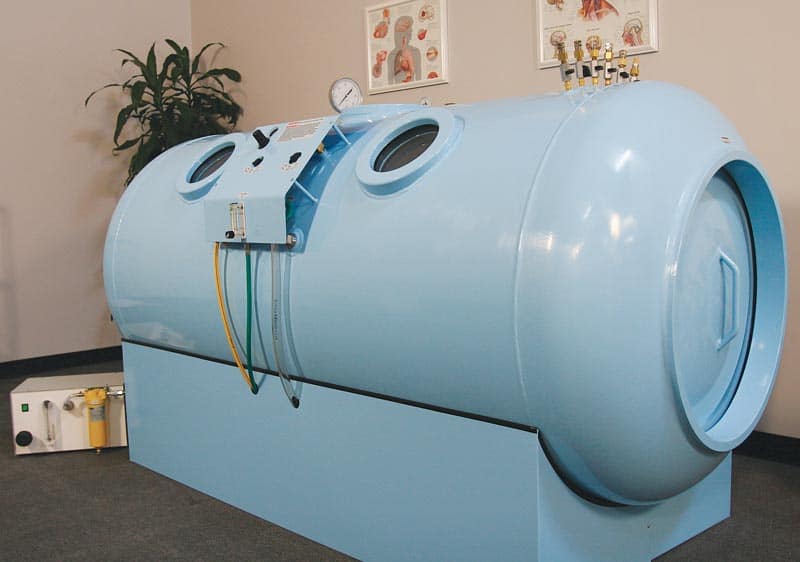HHTM Staff
The Plot
An audiologist reported that a patient of long standing suddenly appeared for an appointment with pressure ventilation tubes (PE tubes) placed in both ear drums. He is over 90 years of age and has a 30+ year history of severe bilateral hearing loss, so the audiologist was surprised and concerned. The surprise came from the fact the patient has never shown any suggestion of middle ear pathology and his eardrums were always (blessedly) intact. The concern ratcheted because, even under the best of circumstances, he hears poorly. The unexpected introduction of middle ear disorder on top of his pre-existing nerve-type hearing loss made him functionally deaf on the day he came in.
A short history revealed that he had been undergoing Hyperbaric Oxygen Therapy (HBOT or HBO2) at a local hospital on a daily basis for several weeks. By report, he experienced “severe” ear pain after the first day of treatment and protested that he did not want to continue. He was referred to an otolaryngologist, was treated, and returned to treatment in the hospital. When this patient went back to his regular audiologist, neither he nor his wife were aware that he had PE tubes in his ear drums, or that his hearing had decreased. They thought his hearing aids were at fault.
The Investigation
The audiologist researched to learn about his treatment, and here’s what was found: Hyperbaric Oxygen Therapy (HBOT or HBO2) is “A mode of medical treatment in which the patient is entirely enclosed in a pressure chamber and breathes 100% Oxygen at a pressure greater than 1 atmosphere absolute… “ (Tarun et al, 2004) Although originally developed for deep sea divers suffering from the “bends”, HBOT has become quite popular in recent years and is used for treatment of wounds (burn, trauma, soft tissue), infections (including infections of the bone), skin grafts, tissue damage from oncologic or radiologic treatment, extreme blood loss, and carbon monoxide poisoning. There are a host of other conditions for which it is purported to be helpful, including sudden hearing loss, tinnitus, and multiple sclerosis, but verification of those claims await replication of results with larger, controlled test groups.
As audiologists, we now need to ask the question “What protocols are in place to identify and protect patients with hearing problems when they are undergoing HBOT?” Further investigation from the audiologist uncovers research papers that looked at “middle ear barotrauma” associated with HBOT. Here are quotes and data summaries from the research:
- “Middle ear barotrauma … is always a consideration in treating both children and adults in a hyperbaric environment.” (Lehm & Bennett, 2003).
- “Hyperbaric oxygen therapy … has been utilized for many years for a multitude of disease entities. One commonly encountered side-effect is otic barotrauma.” (Fiesseler, et al 2008)
- There are risks associated with HBOT, similar to some diving disorders. Pressure changes can cause a “squeeze” or barotrauma in the tissues surrounding trapped air inside the body, such as …behind the eardrum (Wikipedia).
- “Fifteen percent of patients overall (95% CI= 11-19%) required tympanostomy tubes” according to a 4-year study of 325 patients (Fiesseler et al 2008).
The Conclusions So Far:
- About 1 in 6 patients undergoing HBOT will experience middle ear trauma, and that doesn’t even take into account effects of aging on middle ear structures, or handicapping effects of middle ear disease in cases of pre-existing hearing loss, neither of which have apparently been researched sufficiently to warranty publication of data.
- HBO2 protocols to screen for pre-existing hearing problems prior to treatment are not clearly spelled out in the literature that was found. In fact, no protocol has been uncovered.
Where Does This Leave Us?
We would like to hear from anyone who has knowledge of HBOT and its effects on hearing, the protocols associated with induction of patients into the therapy, and any other information associated with HBOT and hearing loss. This information is important to our patients, to our practice, and to audiologists in general!
In the meantime, we urge audiologists to have your patients with hearing loss to contact you prior to undergoing HBOT therapy so you can perform a pre-treatment assessment of hearing and middle ear status.
References
Fiesseler FW, Silverman ME, Riggs RL, Szucs PA (2006). “Indication for hyperbaric oxygen treatment as a predictor of tympanostomy tube placement”. Undersea Hyperb Med 33 (4): 231–5. PMID 17004409.
Lehm Jan P, Bennett Michael H (2003). “Predictors of middle ear barotrauma associated with hyperbaric oxygen therapy”. South Pacific Underwater Medicine Society Journal 33: 127–133.
Tarun Sahni, S. Hukku, Madhur Jain, Arun Prasad, Rajendra Prasad, Kuldeep Singh. Recent Advances in Hyperbaric Oxygen Therapy. Medicine Update. Vol 14, 2004.
Hyperbaric Medicine. Wikipedia.
Feature Image courtesy of New Leaf Hyperbaric







